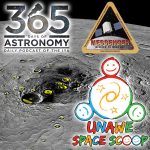Podcaster: Richard Drumm
 Title: Space Scoop: Mercury Shows Us What it Isn’t Made Of
Title: Space Scoop: Mercury Shows Us What it Isn’t Made Of
Organization:365 Days Of Astronomy
Link : astrosphere.org ; http://unawe.org/kids/unawe1134/
Description: Space scoop, news for children
Bio: Richard Drumm is President of the Charlottesville Astronomical Society and President of 3D – Drumm Digital Design, a video production company with clients such as Kodak, Xerox and GlaxoSmithKline Pharmaceuticals. He was an observer with the UVa Parallax Program at McCormick Observatory in 1981 & 1982. He has found that his greatest passion in life is public outreach astronomy and he pursues it at every opportunity.
Today’s sponsor: This episode of “365 Days of Astronomy” is sponsored by — no one. We still need sponsors for many days in 2016, so please consider sponsoring a day or two. Just click on the “Donate” button on the lower left side of this webpage, or contact us at signup@365daysofastronomy.org.
Transcript:
This is 365 Days of Astronomy. Today we bring you a new episode in our Space Scoop series. This show is produced in collaboration with Universe Awareness, a program that strives to inspire every child with our wonderful cosmos.
Today’s story is: Mercury Shows Us What it Isn’t Made Of
The NASA spacecraft MESSENGER had a long and tricky journey to Mercury, the closest planet to the Sun. But astronomers working on the MESSENGER mission announced many new discoveries that show the journey was well worth the effort.
The MESSENGER spacecraft couldn’t head directly to Mercury, because traveling to this planet means going towards the Sun. Literally falling toward the Sun.
This was a problem for MESSENGER, as the pull of the Sun’s gravity would have accelerated the spacecraft and made it travel too quickly to be able to enter into an orbit around Mercury – it would have just flown past it!
To get around this problem, MESSENGER had to take a scenic route and cleverly use the gravity and angular momentum of other planets to slow itself down on the way.
Actually it gave up some of it’s own angular momentum with each of the 6 fly-bys it made, speeding up ever so slightly the planets that it flew past while slowing itself down.
Because of this, MESSENGER’s journey to Mercury took more than six years! It launched on top of a Delta II rocket in August 2004.
Part of it’s slowing down involved an initial fly-by of Earth in August of 2005. Then two Venus fly-bys, in October 2006 and June 2007.
During the second Venus fly-by the Messenger team operated all the science instruments on the spacecraft in preparation for the Mercury fly-bys and orbital science work. The ESA Venus Express spacecraft was orbiting Venus at the time and obtained simultaneous data on the planet.
Then came a series of three Mercury fly-bys. First there was January 2008, then October 2008, and finally September 2009.
It eventually slipped into orbit around Mercury on March 18, 2011. The astronomers working on the mission were eager to start sharing what they had learned – and there have been a few surprises!
For example, scientists had expected there to be lots of iron on the surface of Mercury. To check if this is correct, the MESSENGER spacecraft studied how light bounces off the planet’s surface using several science instruments on the spacecraft.
There is a gamma ray spectrometer, a neutron spectrometer, an X-ray spectrometer, a magnetometer, a laser altimeter, an ultraviolet light spectrometer, an energetic particle & plasma spectrometer and to top it all off a couple cameras to take nice pictures.
But, to everyone’s surprise, its observations with the gamma ray spectrometer have shown that there is unexpectedly little iron on Mercury’s surface. This finding means that astronomers will have to re-think how the planet formed.
In addition, the mission’s magnetometer found out that the planet’s magnetic field is asymmetrical! The field’s center is offset far toward the north of the planet’s center!
They also found carbon-based organic compounds as well. Added to all this they discovered evidence for past volcanism and evidence for a liquid iron core.
MESSENGER is the first spacecraft to orbit the planet Mercury. But another spacecraft, called Mariner 10, flew by the planet way back in 1975.
Hey, Here’s a Cool Fact!
As if all that organic compound stuff wasn’t cool enough, the science team provided compelling support for the discovery of water ice! You heard me right, water ice in permanently shadowed ares of numerous craters in the planet’s north pole! Ice in that blisteringly hot place!
And the ice was discovered by radar from Earth! The giant Arecibo radio telescope in 1991 found unusually bright patches at Mercury’s poles which corresponded to impact craters mapped by Mariner 10 and now in higher quality the MESSENGER spacecraft.
In today’s album artwork is a photograph of Mercury taken by MESSENGER showing in a yellow overlay the radar image of the water ice.
On April 30, 2015, after Messenger had completed its mission, it spent the last dregs of it’s fuel to make a nifty crater on Mercury as it crashed into the planet bringing the mission to an end.
Thank you for listening to the 365 Days of Astronomy Podcast!
End of podcast:
365 Days of Astronomy
=====================
The 365 Days of Astronomy Podcast is produced by Astrosphere New Media. Audio post-production by Richard Drumm. Bandwidth donated by libsyn.com and wizzard media. You may reproduce and distribute this audio for non-commercial purposes. Please consider supporting the podcast with a few dollars (or Euros!). Visit us on the web at 365DaysOfAstronomy.org or email us at info@365DaysOfAstronomy.org. This year we will celebrate more discoveries and stories from the universe. Join us and share your story. Until tomorrow! Goodbye!

